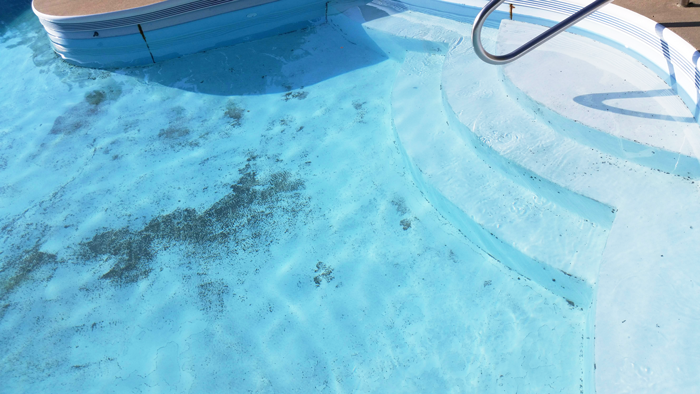By Jim Gay
No commercial aquatic facility wants to have stains in their pools. The most important part of solving stain issues is to identify the type of stain before treatment. The goal is to avoid draining the pool and acid washing it clean. This is especially important when aquatic facility managers are opening pools for the summer and want to have beautiful, stain-free pools with sparkling water.
Luckily, there are many in-pool stain-detection kits designed to narrow down what elements are present in a particular stain, so professionals can confidently determine and recommend the correct stain-removal treatment—without acid washing. It is important to understand how the tests work to ensure stains are diagnosed properly before beginning treatment.
Use a Kit, Not Your Eyes
Pool stains and scale can be tough to treat and often tougher to identify. If a service technician compares a pool stain to others they have seen in the past or are viewing an online photo, or looking at a stain color chart, they are likely setting themselves up for a costly and time-consuming mistake. Many stain and scale issues can look similar to one another, so identifying a surface stain simply by its appearance is not enough. There is nothing worse than recommending or using a particular stain-removal product only to discover it was wrong for the stain.
Stain diagnosis tests were created to determine the composition of the stain and help identify the most effective stain-removal solution.
Criminal (or Chronic) Stain Investigation (CSI)
The stain detection kits on the market today are designed to help understand what stain “crime” has been committed and who or what is to blame.
Think of it a bit like the board game Clue—the point of the game is to rule out culprits of the stain crime and narrow down the list of potential causes. Differentiating between organic and metallic stains is one of the first and most important goals of stain verification. Stain verification kits are specifically formulated for metallic stains. While these products do not detect organic stains, they can eliminate metals as the source of the problem.
These products also help pinpoint when dark patches in liners, or splotchy, inconsistent plaster surfaces are the result of improper surface preparation. Mottling, hydration or liner mold issues are all conditions that find their roots in the pool construction phase. These conditions typically require a physical surface treatment process to remove the source of the stain trapped below the surface level.
Testing Is as Simple as 1, 2, 3
In most cases, the test kits will have a measured amount of dry product to test for stains caused by iron or tannin (tree, leaf or acorn), a second product to test for copper and scale, and a third to oxidize and help lift the surface stain. The products can be used in combination, as many stains are caused by more than one source.
Understanding water conditions is the first step. Information such as the pool’s Langelier Saturation Index (LSI), level of contaminants present in the water and quality of source water can prove invaluable in helping diagnose the principle issue and its underlying cause.
To ensure the quickest and best test results, the water can be adjusted by lowering the LSI and adding a localized sequestering or chelating agent. Creating a more aggressive water environment can produce clearer results and improve the test product performance.
After methodically completing all the tests, pool professionals will be able to narrow down which products will be best suited to remove a specific pool stain before purchasing expensive stain removers.
Test kit pro tip: For ease of access and visibility, pool swim-outs, shallow areas or steps are convenient locations to perform these stain tests. If the stains are in water that is 3 feet deep or more, these diagnosis products should first be poured into a dosing pouch, often included in the test kit, and then dropped onto the stained area.
About the Author
Jim Gay is a 45-year veteran in the pool industry and is the southeast regional sales manager for Haviland Enterprises. He worked with Haviland for more than three years and previously with Jack’s Magic, BioLab, and BioGuard prior to joining Haviland.



